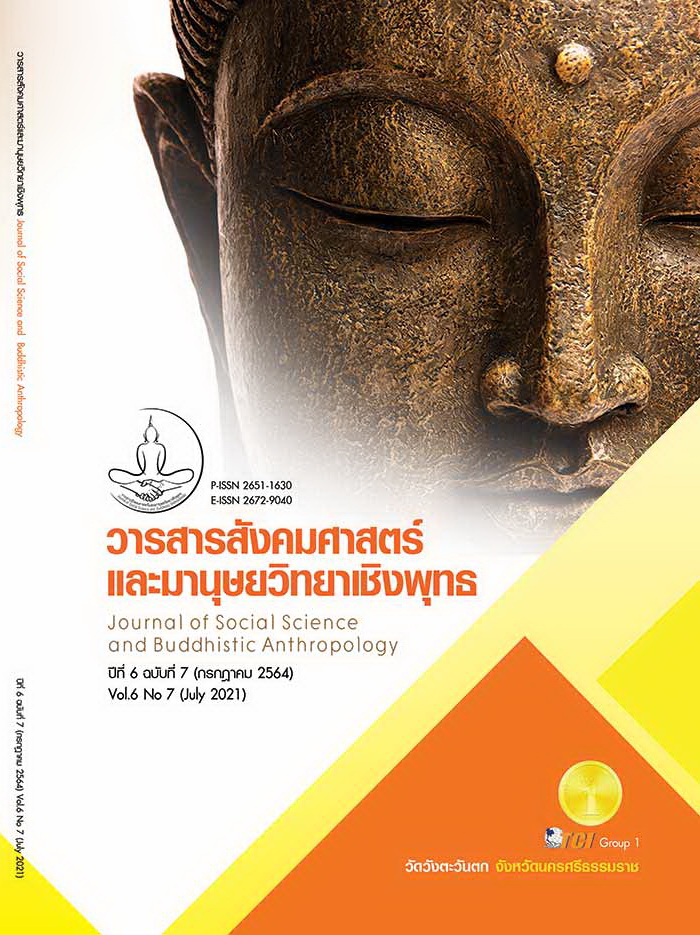CAUSAL FACTORS INFLUENCING QUALITY OF LIFE AMONG TYPE 2 DIABETICS, NAKHONPATHOM PROVINCE
Keywords:
Causal Factors, Quality Of Life, Type 2 DiabeticAbstract
The objectives of this research article were to study the level of causal factors and type 2 diabetic’s quality of life, examine the goodness of fit the model of causal factors influencing type 2 diabetic’s quality of life developed by the researcher with the empirical data and explain the path of causal factors influencing type 2 diabetic’s quality of life. Using a quantitative research model. The population was type 2 diabetics in Tambon Health Promoting Hospital, Nakhonpathom Province, aged 45-79 years. 833 sample size derived by stratified random sampling and simple random sampling. Data collection was questionnaire, reliability 0.95. The data collected were analyzed by descriptive statistics, confirmatory factor analysis and part analysis. The result of research were found as follows: The diabetes mellitus health literacy, motivation to preventing complications, social support, healthy lifestyle and type 2 diabetic’s quality of life are moderate level. The goodness of fit test the model of causal factors influencing type 2 diabetic’s quality of life developed showed that the model was consistent with the empirical data the relative Chi-Square=1.99 CFI=1.00 GFI=0.98 AGFI=0.95 RMSEA=0.04 SRMR=0.03 and the diabetes mellitus health literacy, motivation to preventing complications, social support had direct influence on healthy lifestyle coefficient of influence 0.11 0.16 and 0.26 and had indirect influence on quality of life coefficient of influence 0.09 0.14 and 0.23, healthy lifestyle had direct influence on quality of life coefficient of influence 0.88. The variables in the influence path model were able to account for 79 percent of the variance in quality of life. Suggest that the owner of diabetes work encourages patients to lead a healthy lifestyle by creating a diabetes awareness program. Motivation to prevent complications and build social support participation which resulted in the patient having a higher level of quality of life.
References
กรมควบคุมโรค กระทรวงสาธารณสุข. (2563). กลุ่มรายงานมาตรฐานการป่วยด้วยโรคไม่ติดต่อสำคัญ. เรียกใช้เมื่อ 18 มกราคม 2563 จาก https://www.hdcservice. moph.go.th
__________. (2563). แนวทางการดำเนินงาน NCD Clinic Plus ปี 2563. นนทบุรี: กรมควบคุมโรค กระทรวงสาธารณสุข.
ปัฐยาวัชร ปรากฎผลและคณะ. (2558). คุณภาพชีวิตของผู้ป่วยโรคเรื้อรังที่มีและไม่มีภาวะแทรกซ้อนและแนวทางการพัฒนาคุณภาพชีวิตผู้ป่วยโรคเรื้อรัง. ใน รายงานการวิจัย วิทยาลัยพยาบาลบรมราชชนนีพระพุทธบาท. สถาบันพระบรมราชชนก.
วิชัย เอกพลากร. (2559). การสำรวจสุขภาพประชาชนไทยโดยการตรวจร่างกาย ครั้งที่ 5 พ.ศ. 2557. นนทบุรี: อักษรกราฟฟิคแอนด์ดีไซน์.
สุนทรี สุรัตน์. (2561). ผลของการประยุกต์ใช้โปรแกรมทฤษฎีแรงจูงใจต่อพฤติกรรมการควบคุมระดับน้ำตาลในเลือดของผู้ป่วยโรคเบาหวาน ตำบลแม่คำ อำเภอแม่จัน จังหวัดเชียงราย. วารสารสำนักงานป้องกันควบคุมโรคที่ 7 ขอนแก่น, 25(3), 11-18.
สุภมาส อังศุโชติ. (2557). สถิติวิเคราะห์สำหรับการวิจัยทางสังคมศาสตร์และพฤติกรรมศาสตร์ : เทคนิคการใช้โปรแกรม LISREL. (พิมพ์ครั้งที่ 4). กรุงเทพมหานคร: เจริญมั่นคงการพิมพ์.
สุวรรณี สร้อยสงค์และคณะ. (2562). คุณภาพชีวิตของผู้ป่วยโรคเบาหวานชนิดที่ 2. วารสารโรคและภัยสุขภาพ, 13(2), 37-49.
อภิญญา ศิริพิทยาคุณกิจ. (2010). แรงสนับสนุนทางสังคม: ปัจจัยสำคัญในการดูแลผู้ที่เป็นเบาหวาน. วารสารRama Nurs, 16(2), 309-322.
อัจฉรา สุวรรณนาคินทร์. (2559). คู่มือการพยาบาล การดูแลเท้าเพื่อป้องกันการเกิดแผลในผู้เป็นเบาหวาน. มหาวิทยาลัยมหิดล: คณะแพทยศาสตร์ศิริราชพยาบาล.
American College. (2019). Lifestyle Medicine. Retrieved September 20, 2019, from http://www.lifestylemedicine.org
Bishwajit, G. et al. (2016). Lifestyle Behaviors, Subjective Health, and Quality of Life amongChinese Men Living With Type 2 Diabetes. American Journal of Men s Health, 8(1), 1-8.
Bloom, B. et al. (1971). Hand book on formative and summative evaluation of student learning. New York: McGraw-Hill.
Dunn, S. & Rogers, R. W. (1988). Protection Motivation Theory and preventive health : Beyondthe Health Belief Model. Health Education Research, 1(3), 153–161.
Eun Hyun, L. et al. (2016). A Structural Equation Model Linking Health Literacy to Self - efficacy, Self-care Activities, and Health-related Quality of Life in Patients with Type 2 Diabetes. Asian Nursing Research Journal, 10(2), 82-87.
House, J. S. et al. (1988). Structures and Processes of Social Support. Annual Review of Sociology, 14(1), 293-318.
International Diabetes Federation. (2019). IDF DIABETES ATLAS Nine Edition. Retrieved July 15, 2020, from http://www.diabetesatlas.org
Krejcie, R. V. & Morgan, D. W. (1970). Determining Sample Size for Research Activities. Educationand Psychological Measurement, 30(3), 607-610.
Nutbeam, D. (2000). Health Literacy as a public health goal: a challenge for contemporaryhealth education and communication strategies into health 21st century. London: Health Promotion International.
World Health Organization. (1998). Healthy Living adopted by the WHO Regional Committee for Europe at its forty-eighth session. Copenhagen: World Health Organization.
__________ (2012). WHOQOL User Manual. Copenhagen: World Health Organization.
__________ (2019). Classification of Diabetes Mellitus 2019. Copenhagen: World Health Organization.
Yin Mon, M. K. (2016). Factors Predicting Health-Related Quality of Life in Patients with Type 2Diabetes in Myanmar. Nursing Science, 36(4), 18-27.








